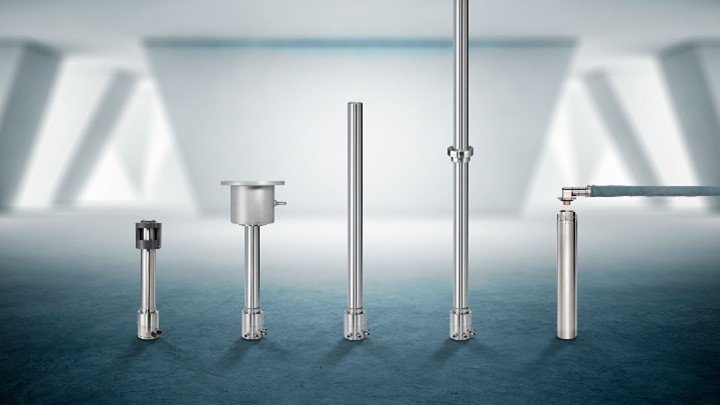The principle of attenuation
The term radiometry can be derived from the two words "radius" and "metiri" - the Latin terms for "ray" and "measure". Simply put, radiometry therefore means "to measure with radiation". Typically, a radiometric measurement system consists of two components (Figure 1): a source that emits gamma radiation and a detector that can detect the incident radiation. In most cases, these two components are placed on the opposite side of the geometry to be measured, such as a vessel or a pipeline. For reasons of radiation protection, the radiation source is housed in a shield made of lead, which emits the radiation only at a certain exit angle.
When the radiation reaches the sensitive detector, it is converted into an electrical signal via light flashes, which is then processed further. The measuring principle is based on a simple but ingenious concept - the principle of attenuation. The gamma radiation passes through the vessel, as well as its contents, and is then detected by the opposite detector. Depending on the amount and density of the material to be penetrated, the radiation is attenuated to a greater or lesser extent - more material and higher density lead to more absorption. The radiation arriving at the detector is thus a measure of the attenuation and, with the use of appropriate calibration, the relevant measured value, such as density or level, can be determined.
Individuality thanks to a broad portfolio
To be able to meet a wide variety of measurement geometries and requirement, there is no one universal radiometric solution. Only through a combination of different sources and detectors is it possible to find the perfect, customized solution for each measurement task. Depending on the application, point or rod sources can be used, various nuclides can be selected, and the activity of the sources can be individually designed. The necessary shielding for the sources is also adapted accordingly. In addition to the sources, there is also a wide variety of detectors available (Figure 2). These differ not only in their size, but also in the material or the available communication interfaces.
Due to the extensive portfolio, many different application areas can be covered where, for example, the level or density is to be determined. For example, measuring systems from Berthold provide important process information in desalters, delayed coker units, alkylation units or FCCs. In addition, Berthold products are used in numerous processes in coal gasification. Customers include some of the world's biggest and best in their field - BP, Exxon Mobil, and Shell, to name a few.
Advantages of contactless technology
As already mentioned, radiometry is widely used in extreme process conditions. One of the reasons for this is the noncontact technology, whereby the measuring components themselves have no contact with the material being measured. Due to the external mounting (Figure 3), installation is very simple and can also be easily retrofitted to existing vessels or pipelines.
One of the biggest advantages of radiometry is that it is maintenance-free and does not require recalibration. The operating costs are therefore low compared to other technologies. Other characteristic properties of this technology are its temperature and long-term stability. Most users have been applying radiometric measurements for several years without any performance problems.
Manageable challenges
Due to the use of radioactive sources, there are quite a few challenges to overcome. These include, for example, the influence of extraneous radiation from weld testing or from a measured product that is itself radioactive. In order to nevertheless provide reliable measurement results, various features are used. All Berthold detectors are equipped with the XIP (X-Ray Interference Protection) external radiation detection, which prevents falsification of the measurement result. The influence due to naturally occurring radioactive substances (so-called NORM) in the measured material can be compensated by using the PRC (product radiation compensation) function. Fluctuations in gas density in the process can also falsify the measured value, but these can be counteracted by using the GPC (Gas Property Compensation) feature. Of course, when using radiometric measurements, all applicable radiation protection regulations must be complied with, which also entails an administrative burden. However, since radiometry is often the only remaining reliable technology, its use is nonetheless justified.
Where process conditions are so extreme that conventional technologies fail, it makes perfect sense to rely on radiometric measurements. Developments in plant engineering show a trend towards more and more extreme conditions, to pushing physical limits and to running plants at the limit of what is technically possible. The technology of radiometry, as exotic as it may seem, will therefore continue to have its raison d'être for a long time to come.




